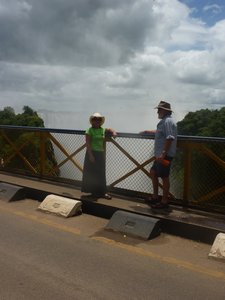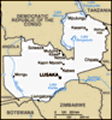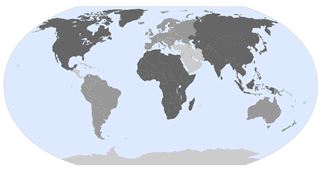Advertisement
Published: March 17th 2010

 We were there shot
We were there shot
On the bridge overlooking the Victoria Falls/Mosi oa Tunya (local beer is called Mosi too)1 Mar to 6 Mar
Livingstone to Ngepi - Travelling in the Wet
Why would you travel through this latitude during the Wet season - especially if you have knowledge of what Wet seasons can be like? Well partly it is because you figured that it would probably be better to hit the Wet here than further north where the roads are considerably worse, but also partly because there is little other option than to hit a Wet season if you travel from North to South or vice versa. It is not such bad deal though. Not like trying to get around Kakadu in the Wet. The roads have generally been OK. Wet tents and flooded campgrounds are a bit exciting but livable - provided that you can get dry soonish.
There is no doubt that Livingstone is the most important tourist icon in Zambia. As the home of the Victoria Falls, Livingstone is fully devoted to tourism. Most of the tourists though seem to stay in the many resorts and hotels scattered around the outskirts of the town. There is little in the town that excites although there are a couple of reasonable restaurants and the normal

 Some of the falls
Some of the falls
They are too big to take a single photorange of bars.
But then why worry about Livingstone? Everyone comes here for the Falls - and they deserve a capital F. As one of the natural wonders of the world the Victoria Falls - or Mosi oa Tunya - needed to hit a high mark in spectacle. They do. I suspect that you really need to see them to experience the power and sheer quantity of water that comes down the Zambezi River at this point. The Wet season obviously added to this part of the experience but the locals assure us that there is still plenty of water coming over even towards the end of the Dry.
Before you get near the Falls you see and hear them. The spray rises hundreds of metres in the air and the roar can be heard for some kilometres. We walked across the bridge that has been built below the Falls which provides a connection between Zambia and Zimbabwe. The bridge is also the site of the bungy jumping, just a couple of metres on the Zambian side of the line. Half a dozen of our intrepid travelling companions took the chance to leap from a perfectly sound bridge,

 Zambezi River
Zambezi River
below the Falls. This is also where the bungy jumping is110 metres towards the river. The distance had been shortened by 15 metres to compensate for the heightened river at this time. The cost for the experience was $US110 but I have no doubt that you would be prepared to pay this to ensure that a professional job was done.
There is another bridge. It was probably built a lot earlier than the one that carries the traffic to Zimbabwe. We walked across this one as well and around a peninsula and an island that provides an excellent close up view of the Falls - and ensure you get extremely wet in the process. The spray is constant but picks up a special power in the gusts of wind. They sell ponchos and raincoats but I have to say that the people who bought them didn't seem much drier than we were at the end of the walk through the park.
In the afternoon Janet and I took a helicopter ride to view the Falls from the air and to take a run down the gorge that has been created as the Falls have moved up the River during the last 7 million years or so. There are

 Another border
Another border
This one on the bridge overlooking the Falls. You go through Zambian Immigration on the way here.2 chopper rides available. One gives you 15 minutes basically just taking in the Falls themselves. The other is the half hour version. The pilot gave us a good look at the Falls and then took us into the gorge and along its various twist and turns. I run out of superlatives here. The Falls from the air are truly an awesome sight. The amount of water, the size but most of all the sheer physical power is massive.
And then down the gorge. There are, I am sure, still bits of my belly somewhere along the run - although there is still plenty left. The drop into the gorge was worth the price of the flight on its own but the run down through the canyon with the chopper often sideways following the series of rapids formed by the Falls as they have retreated was simply a thrill.
The pilot tried to add to the experience by spotting some animals on the way back but, for old Africa hands like us, the sight of a few zebra, antelope and giraffes paled into insignificance with what had gone before.
The night of the visit to the Falls

 Trillionaire money
Trillionaire money
These now-obsolete notes are now an income-earning opportunity for Zimbabweans here.the power went out in the town. Apparently not an unexpected occurrence and catered for by the owners of the establishment in whose grounds we were camped. A massive generator kicked in at 3.00 am - about 20 metres from our tent. They had thought to install a generator and that was good, but not to try to minimise the noise of the bloody thing. No muffiling of the noise, in fact it seemed to have been amplified. Some pretty irritable people wandering around half asleep next morning.
And then it started to rain. And forgot to stop. For the next 24 hours. We spent a pretty nice day around the resort. Paid for wifi internet and up-loaded some photos, sorted out a couple of blog posts, checked out accommodation in Capetown and France and dealt with emails. There was also a nice bar and the day was topped off by a sunset cruise - sans sunset but with plenty of free drinks.
Janet had parked her tent in a nice little spot away from the general run in a nice shady hollow where there were no ants. By the time she was ready for bed though there

 Sunset over the Zambezi
Sunset over the Zambezi
This was the day before the big rain.was rather a lot of water, some of it running through her tent. We shifted her to higher ground and, to be sure to be sure, shifted our own tent a couple of metres higher. Next morning the water was lapping our tent and Janet - who checked hourly throughout the night - reckons it was precisely 4 short steps from hers.
From Livingstone it was straight into Botswana to Kasane and the Chobe National Park. In a way the Wet is the wrong time to see these parks. There is plenty of feed for the animals and lots of water laying around. The animals have lots of options that allow them to stay out of sight and, sensibly, they take them. Our early morning game drive picked up many puku, impala, water bucks and a lot of birds but none of the big predators or even elephants. Our run on a boat in the afternoon down the Chobe River was more successful with a lot of hippos and a decent mob of elephants.
But national parks are not just about animals for me. I find it very enjoyable just moving through this countryside looking at the different

 Puku
Puku
in the Chobe National Parkvegetation and water courses. A little boring for some I guess but the animals reallly are a bonus rather than the main game for me.
The borders of Botswana, Namibia and Angola are all pretty close in this part of the world. The Okavango Delta is obviously a highly sought after piece of land and all three seem to have been able to have charge of some of it. The Angolans provide the water but don't seem to have much of the land. Botswana and Namibia share the rest as far as I can tell. Hence we moved back and forward through border crossings between these two countries a few times. Luckily, they were pretty efficient, no nonsense crossings. A little disappointing though that we seem to have moved out of the zone of confused crossing points with sellers and money changers all over the place, large queues of trucks and grog stalls
Ngepi Camp is another camp set up for the overlanders and similar beings. Well set up bar, good camping facilities and the capacity to up-grade to a room or a cabin for those who need a break from the tent for whatever reason. We are

 Botswana's national bird
Botswana's national bird
Must google the name of itreally getting used to these. They have some disadvantages. They are normally out of town for some good reasons - space, ease of security and to have a nice site - but we are missing the connection with the locals that we were able to get shopping and living in and among them.
Ngepi was just the second time we have upgraded on the trip. The first was a place in Egypt where it was just a dollar to upgrade to a room. This one was my fault. I spun to try to catch a frisbee like I used to be able to. On this occasion my knee decided that that was stupid and gave up working for a little while. Getting better now but rolling around in a tent was not an attractive option that night. It was just a little unfortunate that it didn't rain that night. It would have been nice to justify the decision through superior knowledge of the weather rather than just wimpishness. But you can't have everything.
I should be able to upload this soon but, while there is a bit of internet around it is still pretty slow and thus hard

 The animal that sat on a painted toilet seat
The animal that sat on a painted toilet seat
this description by our guide was so apt we've forgotten the name of the animalto get photos up. We will be in and out of national parks for a while so it may be a while. We have also had problems with our camera for a while. Those with a keen eye will spot the blemishes caused by scratches on the lens. Caused by dust I think, some of which has made it into the zoom mechanism and is causing a lot of difficult with the automatics of the camera. Now how is that for a technical description? Bottom line is that we need to get it fixed in Capetown and try to get some reasonable photos until then. Also on the equipment front, the Font of Knowledge - aka our external hard drive - was caused to spear into the ground in a bar in Dar. It has not really worked since. All of the information and photos are still there of course, all 270 GB of it. We just need to find someone who can access it and put it where we can also access it. The back up system is in place and working and we will get the Font downloaded in Capetown I think.
I will do an equipment
review when I have time just to give credit where it is due and to warn on some things that have not performed so well.
Next post will take in the Okavango Delta, the San Bushmen and the Etosha National Park.
Advertisement
Tot: 0.06s; Tpl: 0.013s; cc: 15; qc: 26; dbt: 0.0266s; 1; m:domysql w:travelblog (10.17.0.13); sld: 1;
; mem: 1.2mb
























